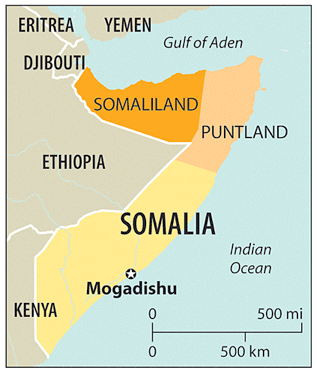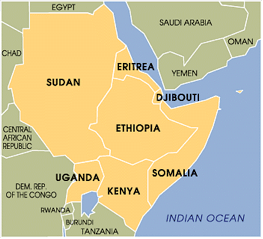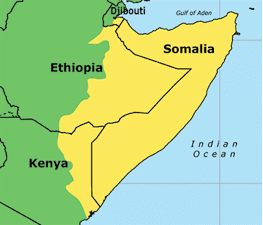
webmaster
© Copyright DEHAI-Eritrea OnLine, 1993-2010
All rights reserved
From: Berhane Habtemariam (Berhane.Habtemariam@gmx.de)
Date: Fri Jul 23 2010 - 17:59:43 EDT
Somalia: Al-Shabab, extremism and US allies
Yohannes Woldemariam
2010-07-23, Issue <http://www.pambazuka.org/en/issue/491> 491
<http://www.pambazuka.org/en/category/features/66120>
http://pambazuka.org/en/category/features/66120
rise of Al-Shabab in Somalia must be seen in the context of decades of
mismanagement, dictatorship and abuse, writes Yohannes Woldemariam.
Following Ethiopia's US-backed intervention in 2006, the ascendancy of
Somalia's moderate UIC (Union of Islamic Courts) was blocked and some
300,000 people were displaced, in the wake of which 'the Al-Shabab
extremists triumphed as a hegemonic force' from within the UIC. And as the
dust settles on last week's Kampala bombing, Woldemariam contends, the
governments of US allies Ethiopia and Uganda are once again seeking to
capitalise on the tragedy for their own ends, 'with Obama playing right into
it'.
The emergence of Al-Shabab in Somalia is not an accident. It stems from many
decades of mismanagement, dictatorship, regional and international abuse.
Superficially, one expects Somalia to be a unified entity because all
Somalis speak a common language and are not plagued by ethnic differences as
in many parts of the post-colonial world. Yet Somalia was always beset by
deep clan cleavages even as Somali elites fantasised about the notion of a
'Greater Somalia' and made it their mission to unite all Somali-speaking
peoples. This included Somalis in neighbouring states: the Ogaden region in
Ethiopia, the Issas in Djibouti and the Somalis who inhabit the area known
as the Northern Frontier District of Kenya. The Horn of Africa was of course
faced with the same arbitrariness of borders inherited from colonial rule,
where there were cultural links with people across borders.
But the project of an ethnically homogenous state by embracing neighbouring
Somali minorities was a non-starter and contrary to the African charter of
respecting colonial boundaries. Hence, Somali irredentism pitted it against
Kenya and Ethiopia, worsening in particular its historic enmity with
Ethiopia. The tension between the two countries provided one of the openings
for the Soviet Union and the United States to use these nations as proxies
in the geopolitical games of the Cold War. The Horn of Africa of which
Somalia is a part became much like Afghanistan, Vietnam and other hot spots
of that era.
Ethiopia and Somalia waged two major wars, including one that involved Cuban
troops in 1977-78. A combined force of Ethiopians, 15,000 Cubans, 1,500
Soviet advisors and weaponry broke the back of the Somali army. This defeat
was the beginning of the end of a functioning Somali state. It was followed
by a protracted civil war in the 1980s, culminating in the disintegration of
the country. Clumsy US and UN involvement in the 1990s made an already bad
situation worse. Clan-based warlordism replaced the centralised dictatorship
of Mohammed Said Barre, who ruled Somalia from 1969 to 1991. After the fall
of Barre, Somaliland and Puntland became two separate, relatively stable but
unrecognised entities. In fact, in late June 2010, Somaliland held the only
election in the region which met international standards. Opposition
candidate Ahmed M. Maha Silanyo won the election, defeating incumbent
President Dahir Riyale Kahin. In contrast, anarchy had reigned in southern
Somalia and the Mogadishu area for at least the last two decades.
http://www.pambazuka.org/images/articles/491/horn_map2.gif
For the most part, the US disengaged after the death of 18 of its marines
and the downing of two Black Hawk helicopters in 1993. The gruesome scene in
October 1993 - with pictures of a dead American soldier being dragged
through the streets of Mogadishu and dubbed the 'CNN effect' - is a fixture
in the memory of many Americans. It influenced the Clinton administration's
decision to withdraw US troops from the country. Somalia became of renewed
interest only after 9/11 out of concern that it would be a breeding ground
for global jihad and a hide out for Al-Qaida elements.
There were 14 unsuccessful top-down attempts for a centralised government in
Somalia between 1991 and 2010. The current Transitional Federal Government
(TFG) led by Sharif Sheikh Ahmed is the latest mutation of these trials.
Most Somalis view Sharif Ahmed as an Ethiopian puppet, but Hillary Clinton
had called him the 'best hope' for his country. He barely controls two
blocks in Mogadishu and only because of the protection of approximately
3,000 Ugandan and 2,000 Burundian troops representing the ill-conceived AU
Mission In Somalia (AMISOM). The Ugandan, Burundian and Ethiopian
intervention is deeply resented by Somalis of various political persuasions.
The justification for their presence is ostensibly to keep peace, but there
is no peace to keep in Somalia. Uganda and Ethiopia really need peace within
their own borders before pretending to bring peace to other lands. Among
several insurgencies within Ethiopia is the Ogaden National Liberation Front
(ONLF), which is waging a perennial struggle for self-determination for the
four million or so ethnic Somalis. It has claimed thousands of lives and is
being called 'the other Darfur' by some observers. Since the 1980s, Uganda's
northern region has also been ravaged by a murderous group known as the
Lord's Resistance Army (LRA).
The primary reason for Ethiopian intervention is its vested interest in a
weak and disintegrated Somalia. It also benefits from American financial,
military and political support by positioning itself as an ally in the 'war
on terror'. Ethiopia receives the largest amount of American aid of any
country in sub-Saharan Africa. Similarly, Uganda and Burundi are intervening
to garner support from the United States when they don't even share a common
border with Somalia.
http://www.pambazuka.org/images/articles/491/horn_map3.gif
In return, the US keeps mum when these leaders rig elections or change
constitutional clauses to enable them to extend presidential terms. It is a
Machiavellian game all around.
If one were genuine about peace, Ethiopia would be among the last countries
in the world to be encouraged to send troops to Somalia. Yet in 2006, it
intervened in Somalia with American support and pre-empted the ascendancy of
the Union of Islamic Courts (UIC), who were relatively moderate Muslims and
had managed to establish a modicum of order for the very first time in 15
years. From the ranks of UIC, the Al-Shabab extremists triumphed as a
hegemonic force. Ethiopia officially withdrew in 2009, but only after
experiencing a quagmire which plunged Somalia into deeper chaos, displacing
300,000 Somalis and causing disarray for a grassroots movement that had
seemed promising before it was nipped by Ethiopian intervention. And this
official withdrawal notwithstanding, Ethiopian troops still make periodic
incursions into Somalia at will.
Given the predatory nature of the governments of Burundi, Ethiopia and
Uganda - which are essentially military dictatorships or de facto one-party
control - little faith can be placed in them for enhancing regional
stability in the Horn region. Current Kenyan President Mwai Kibaki is also
believed to have stolen the presidential election from Raila Odinga (who
happens to hail from the same ethnic group as Barack Obama's father), who is
now prime minister in a shaky power-sharing government. Yet the country is
an ally in security matters in the region and therefore immune from any
serious US scrutiny.
In 2006, the Bush administration provided intelligence to Ethiopia in
support of the invasion. It also used military facilities in Djibouti,
Ethiopia and Kenya to launch air raids and missile strikes against Al-Qaida
suspects at several sites in Somalia in 2007 and 2008. The air attacks
killed several dozen Somali civilians and injured hundreds more, and they
made US backing for the invasion highly visible. These periodic airstrikes
are continuing under the Obama administration. The killing of Somali
civilians only serves to drive Somalis into desperation and extremism.
AMISOM is not any better. There are credible reports that it is responsible
for civilian deaths and other excesses.
In the aftermath of the Kampala bombings, Obama said that Al-Qaida is racist
and doesn't care about African lives. No sane person would dispute that.
However, the real question is whether Obama cares about African lives. If he
truly does, why would he meddle and prop up dictators like Meles Zenawi of
Ethiopia and Yoweri Museveni of Uganda, dictators who wilfully sacrifice
their soldiers and the lives of innocents for some foreign exchange dollars?
Not surprisingly, both Zenawi and Museveni are already positioning
themselves to argue for expanded intervention and to milk the Kampala
tragedy, with Obama playing right into it. Ironically, Al-Shabab will also
welcome the escalation and regionalisation of the conflict in the hope of
bolstering its waning domestic support base as ordinary Somalis become weary
of the heavy-handed repression by the movement.
Relying on Ethiopia, Uganda and Burundi for keeping peace in Somalia is like
sending Indian soldiers to occupy and pacify the Pakistani tribal areas. It
is an oxymoron. It undermines the moderates and helps the extremists. The
willingness of the United States to endorse interventions is rarely matched
by a commitment to a comprehensive effort of securing peace. With the
quagmire in Afghanistan and Iraq, there is hardly any political will in the
US to effectively deal with the complexities of the issues in Somalia.
Somalia does not need intervention and further militarisation by
self-serving neighbours. A possible starting point for rebuilding Somalia
could be to use the money that is being wasted on AMISOM to assist the
Somali people and the nascent democratic experiment in Somaliland in light
of the severe democratic drought in the region.
http://www.pambazuka.org/images/articles/491/horn_map.gif
Notion of 'Greater Somalia' marked in yellow on map



----[This List to be used for Eritrea Related News Only]----
